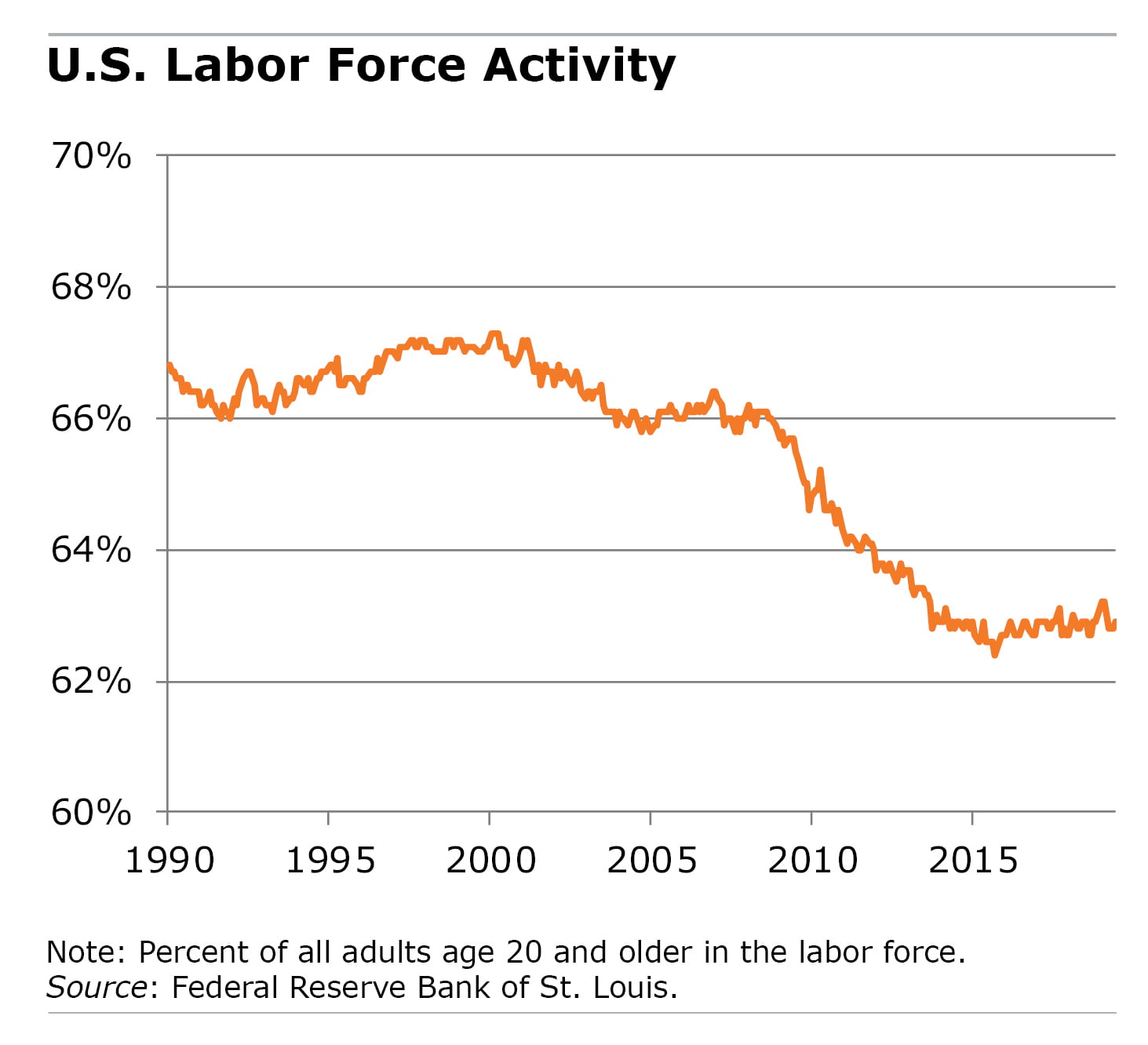
People in their Prime are Working Less
 The decline in Americans’ labor force activity started around the year 2000 and accelerated after the 2008-2009 recession. Labor force participation is now at its lowest level since the 1970s.
The decline in Americans’ labor force activity started around the year 2000 and accelerated after the 2008-2009 recession. Labor force participation is now at its lowest level since the 1970s.
The main reason for the drop is our aging population. But the news in a systematic review of current research in this area is a more troubling trend that’s also driving it: people in their prime working years – ages 25 through 54 – are falling out of the labor force.
Prime-age men are the most active members of the labor force. Yet in 2017, only 89.1 percent of them were either working or seeking a job, down from 91.5 percent in 2000, according to the review by University of Southern California economists.
Prime-age women’s labor force activity also fell, to 75.2 percent in 2017 from about 77 percent in 2000. This decline ends decades in which women were streaming into the nation’s workplaces at an increasing rate. One possible reason for the leveling off is the scarcity of family-friendly policies, including more generous childcare assistance.
The forces pushing and pulling various groups in and out of the labor force make it difficult to pin down the primary reasons for the overall drop in participation. The decline among prime-age men and women may be tied to opioid addiction, alcoholism, and suicide. Other studies point to the surge in incarcerations of black men.
And while technological advances like robots and growing trade with China have increased the need for many highly skilled workers, they have reduced the demand for less-educated, lower-paid people, including U.S. factory workers, in their peak working years. The resulting fall in their wages has also made work less attractive to them.
More needs to be done to understand why the labor force has dropped off, but the study concludes that societal changes – more than the business cycle – are fueling this major shift.
To read the study, authored by Francisco Perez-Arce, Maria Prados, and Tarra Kohli, see “The Decline in the U.S. Labor Force Participation Rate.”
The research reported herein was performed pursuant to a grant from the U.S. Social Security Administration (SSA) funded as part of the Retirement Research Consortium. The opinions and conclusions expressed are solely those of the author(s) and do not represent the opinions or policy of SSA or any agency of the federal government. Neither the United States Government nor any agency thereof, nor any of their employees, makes any warranty, express or implied, or assumes any legal liability or responsibility for the accuracy, completeness, or usefulness of the contents of this report. Reference herein to any specific commercial product, process or service by trade name, trademark, manufacturer, or otherwise does not necessarily constitute or imply endorsement, recommendation or favoring by the United States Government or any agency thereof.
Comments are closed.







I wondered when this would surface again. The number of discouraged workers who’ve dropped from the workforce is not accurately reflected in the so-called unemployment stats all administrations like to tout. The true unemployment rate is about three times the “official rate.”
It’s a worrying trend without a doubt. Automation is playing a larger role in removing the demand for low-skill labor, while the number of low-skill workers looking for work continues to climb.
Reeducation and training should be a major part of solving this issue.
Discouraged workers? Maybe.
Work entails costs — commuting, child care, and in cases where you have had a local economic decline, perhaps moving.
The generation ages 25 to 54 is being paid far less than previous workers were at the same age — 25 percent less.
Is that lower pay worth uprooting yourself, moving away from friends and family, and paying for an extra car? Maybe not if there is an alternative.
Work has to pay. If all the value goes to the one percent — and the richer retirements older generations promised themselves but were unwilling to pay for — why do it?
I’m always shocked at how many people stay in jobs that never let their true potential shine. We need to help give people more self-awareness earlier in life so they don’t fall into a career that they hate until they die.